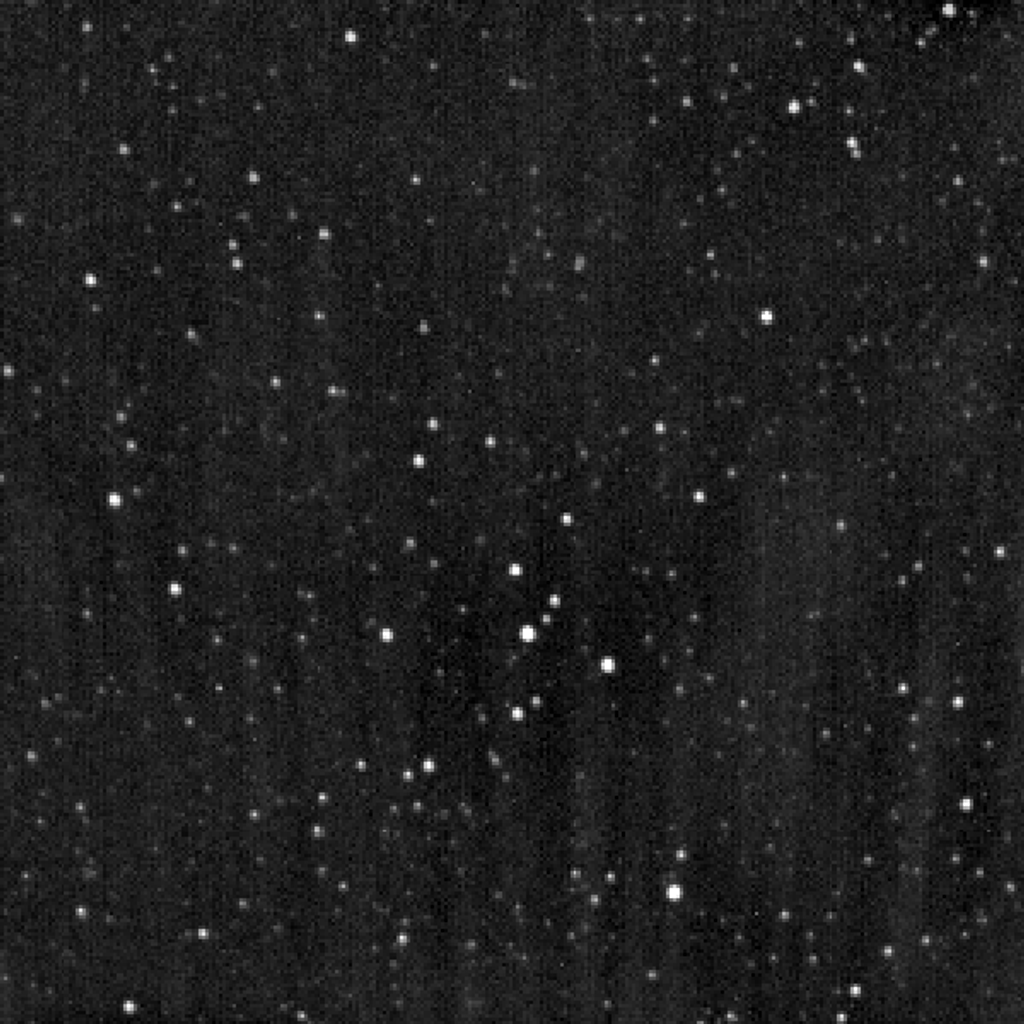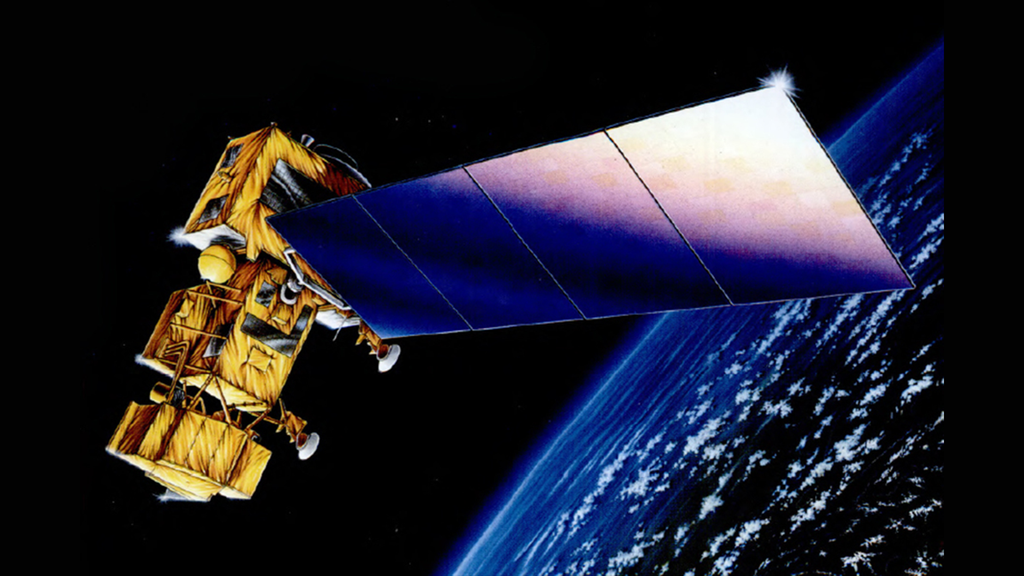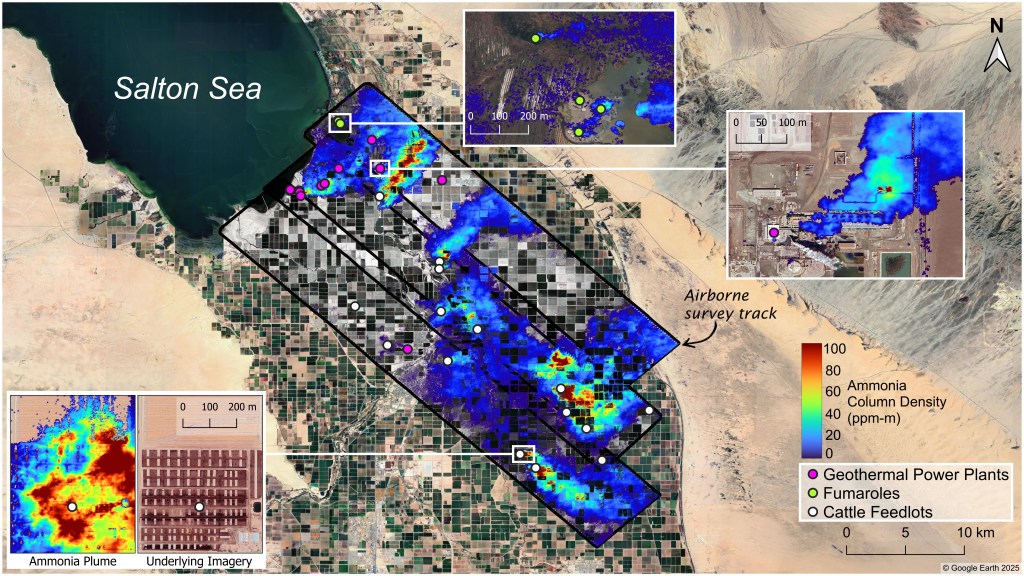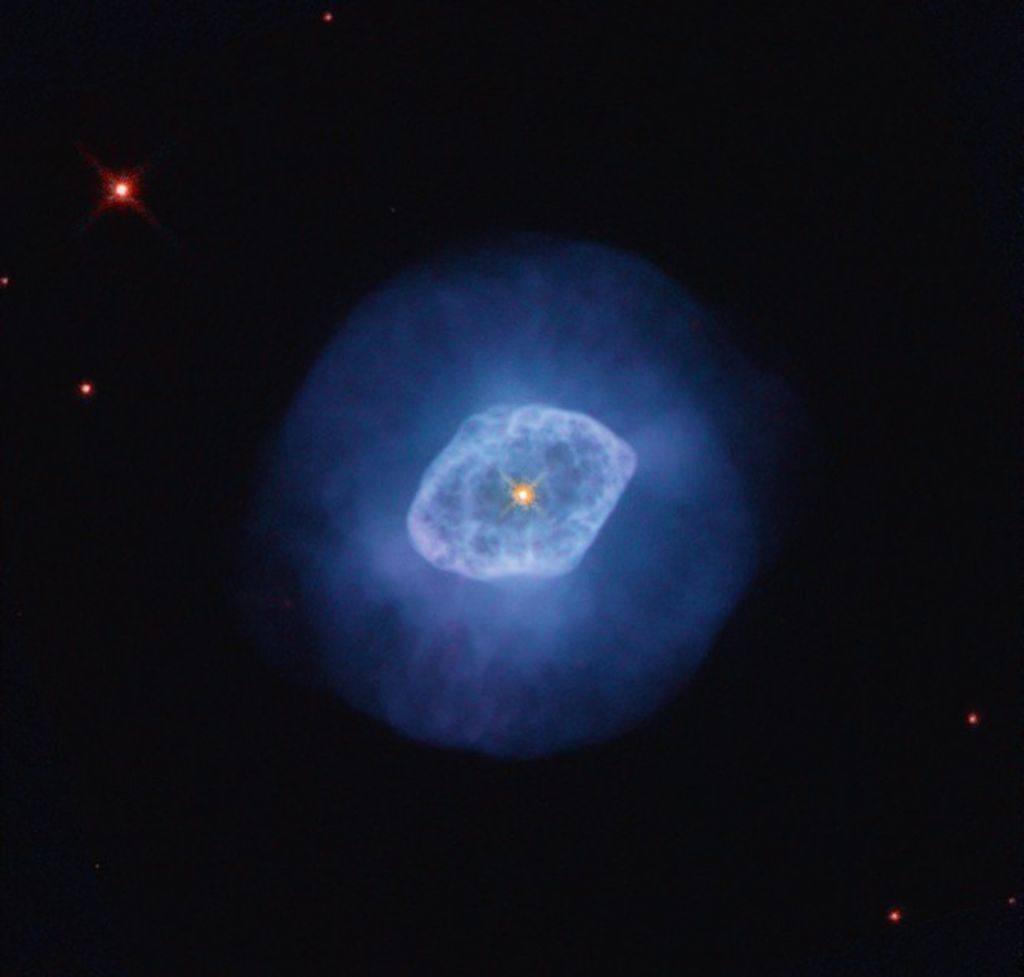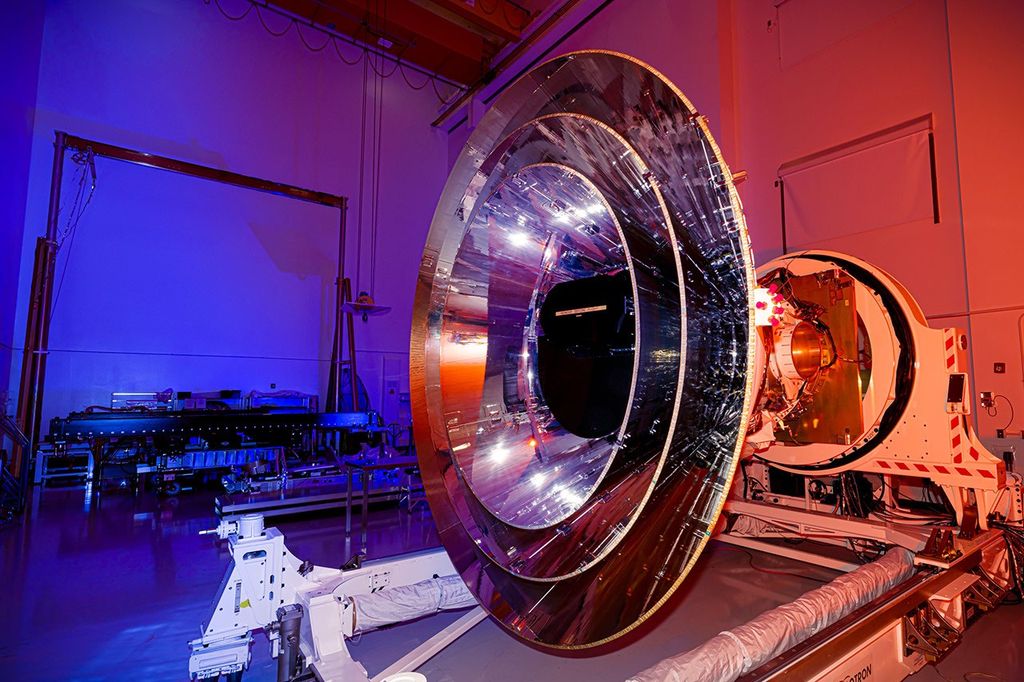BACKGROUND INFORMATION: NGC 7027
The object NGC 7027 is a star entering the final stages of life. It is going through spectacular death throes as it evolves into what astronomers call a "planetary nebula." A nebula is a visibly diffuse region composed of gas and dust. The term planetary nebula came about not because of any real association with planets, but because in early telescopes objects of this type often appeared planet-like to the astronomer – even glowing with a bright green color. We now know that green color to be from very hot oxygen atoms in the gas surrounding the central star.
After a star has depleted the majority of its nuclear fuel, profound changes occur as it enters a poorly understood phase of evolution. First, a combination of stellar pulsations and radiation pressure drives the atmosphere outward, forming an extended envelope around the star. The envelope can be so large that, if such a star were our Sun, the gas and dust expelled from the star might extend many times farther out than the average distance of the planet Pluto to the Sun (this will in fact be the Sun's fate). During this period the star loses material at very high rates; a star several times the mass of the Sun might shed an amount equal to the total mass of the Sun in less than 10,000 years. The wind that propels the envelope has speeds in excess of 43,000 miles per hour.
The gas in the circumstellar envelope is mostly made up of simple molecules such as molecular hydrogen and carbon monoxide, combined with several other gases such as cyanide, sodium chloride, and possibly water vapor. Complex hydrocarbon molecules are also known to be present in circumstellar envelopes. Most importantly, the material cast off during this phase of stellar evolution includes a large abundance of the key elements to the origin of terrestrial life – carbon, nitrogen, and oxygen. These elements are created through nuclear fusion of hydrogen and helium in the stellar core.
While the envelope is being formed and ejected into the interstellar medium, the central star of the young planetary nebula continues to evolve. Its surface heats to temperatures in excess of 360,000 degrees F. The increase in ultraviolet radiation as the star heats first dissociates the molecules in the envelope and then ionizes the constituent atoms. This transition phase is very short – perhaps less than 1000 years. We have caught NGC 7027 at a very important time for study – in the middle of this transformation. It has a hot central star surrounded by an ionized region of gas; external to which is the remnant stellar envelope made up of molecules and microscopic dust particles. The molecules in the envelope of NGC 7027 are being destroyed into their constituent atoms and ions. This is an object that will survive in its present state for only the blink of an eye (in cosmological time).
BACKGROUND INFORMATION: HST AND NICMOS IMAGING – THE INFRARED VIEW
In February 1997, following a spectacular nighttime launch, astronauts aboard STS-82, the 22nd mission of the Space Shuttle Discovery, installed a new set of instruments in the Hubble Space Telescope. One of those instruments, the Near-Infrared Camera and Multiobject Spectrometer (NICMOS) is designed to observe at wavelengths outside our normal view – the infrared – giving HST new eyes on the Universe.
The composite color image of NGC 7027 is among the first data of a planetary nebula taken with NICMOS. This image is new and unique, because it probes wavelengths of light we cannot see directly with our eyes with clarity never before achieved. The image is not exactly what it might at first appear – a color photograph. It is in fact a "pseudo" color image of how the object appears at wavelengths outside our normal view. This picture is actually three separate images taken at different wavelengths (1.10, 2.12, and 2.15 microns). The shorter wavelength is coded to blue and the longest to red and green. The red image is most sensitive to emission from one type of molecule, the most abundant one in the Universe – molecular hydrogen. Until NICMOS was installed, HST could not see emission from this important molecule. When combined with earlier HST/WFPC2 data of NGC 7027, a much more complete understanding can be obtained.
These NICMOS data reveal a wealth of new information. The often difficult to see central star of this object is clearly seen here in the near infrared. Surrounding it is an elongated apparently ring-shaped region of gas and dust cast off by the star. This region is highly ionized – atoms ripped apart into nuclei and electrons by radiation from the hot central star. This gas (appearing as white, and off white) has a temperature of several tens of thousands of degrees. We find that the object has two "cones" or "wings" of emission from molecular hydrogen (the red material) stimulated to glow in the infrared by ultraviolet light from the star – a process known as fluorescence. Molecular hydrogen glows in this way where it is being violently split into separate hydrogen atoms by the stellar ultraviolet radiation. It appears as it does in this image, because the cones are highly inclined to our line of sight. These "cones" end with rings of bright molecular hydrogen emission. In images taken at wavelengths where molecular hydrogen does not emit, the closest ring to the Earth can be seen as a dark band across the center of the nebula. This is caused by a large abundance of dust in this region, resulting in the light from behind to be attenuated along our line of sight. Outside of the of bright regions seen in these data is not just empty space, but is actually where most of the material shed by the star remains. It is invisible in this image because it is still shielded from the radiation of the star by material interior to it – obscured like trees in a forest.
Another interesting feature of these data is the appearance of a disturbance that might be caused by an as yet unseen jet of material that is inclined from the main axis of the object. If correct, the jet appears to extend symmetrically from the upper left to lower right of the image. In other planetary nebulae, similar types of jets can have speeds in excess of 150 miles per second.
From even the best ground-based telescopes, NGC 7027 looks fuzzy. This is in part because of the distorting effects of the Earth's atmosphere. It is also very small in appearance from the Earth. Spanning only about 15 seconds of arc on the sky, it is one of the smallest objects of its kind to be imaged by HST. Seeing the structures clearly as we do in this image is like seeing the face of Roosevelt on a dime at a distance of twenty miles. The actual size of the nebula is approximately 14,000 times the average distance between the Earth and Sun (or 14,000 times 93 million miles). HST and NICMOS have made it possible for us to see clearly for the first time the true nature of NGC 7027.
NICMOS has allowed astronomers to see clearly the interface from hot, glowing atomic gas to cold molecular gas. The origin of the newly seen filamentary structures is not well understood. The interface region is the pink and red colored cool molecular hydrogen gas. While WFPC2 is best used to study the hot, glowing gas, which is the bright, oval-shaped region surrounding the central star, NICMOS allows us to see deeper into the nebula and view material that cannot be seen at visible wavelengths. The material beyond this core is illuminated by light from the central star reflecting off dust in the cold gas surrounding the nebula. Combining exposures from the two cameras allows astronomers to clearly see the way the nebula is being shaped by winds and radiation.
It is data of this type that will aid astronomers to understand the complexities of stellar evolution – both early and late stages. An understanding of the physical and chemical processes that are taking place in the important transition zone viewed by NICMOS has importance to many other areas of astronomy, including a better understanding of the processes that take place in the regions surrounding new born stars.
These data were acquired as part of a HST/NICMOS study of compact planetary nebulae and proto-planetary nebulae (Objects with central stars still too cool for it to ionize the core region.). NGC 7027 is located about 3,000 light-years from the Sun in the direction of the constellation Cygnus the Swan.
BACKGROUND INFORMATION: STELLAR METAMORPHOSIS – HUBBLE SPACE TELESCOPE PICTURES OF BUTTERFLY-LIKE NEBULAE EMERGING FROM STELLAR COCOONS
Stars do not live forever. The Sun, for example, was born approximately four and half billion years ago, and is expected to have another 5 billion years left in its life. What is the eventual fate of the Sun, and stars like it? It is a popular myth that stars explode when they die, and violent events such as supernova explosions were thought to be the norm. Dr. Sun Kwok of the University of Calgary in Canada has promoted the idea that most stars do not explode, but undergo a quiescent death. The majority of stars, in fact over 95%, will go quietly – in other words "not with a bang but a whimper". This theory has been confirmed by observations from space, including observations from the Hubble Space Telescope.
During the last ten thousand years of a star's life, it goes through a glorious stage called "planetary nebula" phase, during which the star gives off a magnificent display of light (see recent releases of HST images of planetary nebulae). In order to better understand the cause of death of stars, we have to look back a few hundred years before the planetary nebulae phase, and examine the state of stars before they undergo this transformation. Over the past decade, Dr. Sun Kwok and Dr. Hrivnak have been searching for such stars, the very old stars which are just beginning to get "sick". Now two such "patients" have been imaged with the HST. The high quality HST pictures have provided much needed information for the diagnosis of the cause of death of stars.
The accompanying pictures are HST WFPC2 images of two "proto-planetary nebulae": the "Cotton Candy Nebula" (IRAS 17150-3224) and the "Silkworm Nebula" (IRAS 17441-2411). In both cases, we can see a series of concentric rings, representing the "puffs" given off by the star in the last few thousands years of their lives. These "puffs" provide evidence that the star has been "ill" for some time. After a number of these "puffs", the star wraps itself inside a cocoon. In these two HST images, we are seeing the first indication that the nebulae are emerging from their cocoons, like butterflies undergoing metamorphosis.
These observations were made with the HST WFPC2 camera in cycle 6 under GO program 6565 (Kwok et al.: Imaging of Proto-Planetary Nebulae". We have also made use of data in the public archive obtained under the snapshot program 6364 (Bobrowsky et al.: Snapshot survey of protoplanetary nebulae and AGB stars). These results will be published in an upcoming issue of Astrophysical Journal Letters.
Dr. Sun Kwok has published extensively in the field of planetary nebulae and is best known for his theory of planetary nebulae formation. He is the current chairman of the International Astronomical Union Working Group on Planetary Nebulae.
BACKGROUND INFORMATION: NGC 6818
NGC 6818 is in the constellation Sagittarius at a distance of about 6000 light-years. It has a diameter of about 0.5 light-year. The Hubble telescope observation was taken March 10, 1997 by the Wide Field and Planetary Camera 2.
This is a composite of images taken in 3 filters: Halpha is red, Hbeta is blue, and [O III] (doubly ionized oxygen) 5007 is green. As a result of the longer exposure time at Hbeta, the central star of the planetary nebula appears blue. We see a roughly spherical outer envelope as well as a brighter vase-shaped interior "bubble". Astronomers believe that a fast wind from the hot central star is creating the elongated shape and in fact has caused a "blowout" at the two ends of the major axis (lower right and upper left).
This nebula looks like a twin of NGC 3918, another planetary nebula (PN) that has been imaged by the Hubble telescope. The structure of NGC 3918 is remarkably similar to that of NGC 6818 – it has an outer spherical envelope, an inner brighter elongated bubble, and it also shows a blowout orifice at one end of the major axis in the bottom right-hand corner. By finding and studying such similar objects, it is hoped that crucial details can be learned about the evolutionary life history of planetary nebulae. One could call this "comparative PNology."






